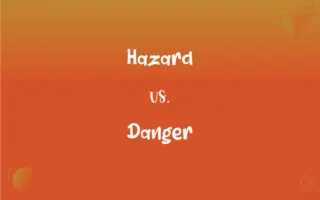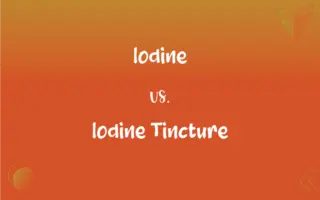Asbestos Sheet vs. Cement Sheet: What's the Difference?
Edited by Aimie Carlson || By Janet White || Published on February 24, 2024
Asbestos sheets are building materials containing asbestos fibers, known for fire resistance but hazardous to health, while cement sheets are asbestos-free, made from a mixture of cement and reinforcing fibers.

Key Differences
Asbestos sheets are composed of asbestos fibers, a natural mineral known for its heat resistance and durability. They were widely used in construction for roofing, insulation, and fireproofing. Cement sheets, also known as fiber cement sheets, are made from a mixture of cement and reinforcing fibers, and serve as a safer alternative to asbestos sheets. They are used in similar applications, such as roofing and wall cladding.
The key concern with asbestos sheets is health-related. Asbestos fibers, when disturbed or damaged, can become airborne and pose severe health risks, including lung cancer and mesothelioma. Cement sheets, however, are generally considered safe and do not pose the same health risks as asbestos, making them a preferred material in contemporary construction.
Asbestos sheets, due to their hazardous nature, have been banned or heavily regulated in many countries. In contrast, cement sheets are widely used due to their safety, durability, and ease of installation. Both materials are resistant to fire and pests, but cement sheets also offer better environmental sustainability.
In terms of appearance, asbestos sheets often have a distinct fibrous texture, while cement sheets tend to have a smoother finish and are available in various textures and designs. This versatility makes cement sheets more adaptable for modern architectural needs.
The use of asbestos sheets has significantly declined due to the health risks and legal restrictions. In contrast, the use of cement sheets has grown, favored for their safety, versatility, and compatibility with various architectural styles.
ADVERTISEMENT
Comparison Chart
Composition
Asbestos fibers
Cement and reinforcing fibers
Health Risks
High (cancer, respiratory issues)
Low to none
Usage
Historically in roofing, insulation
Roofing, cladding, and various construction uses
Legal Status
Banned or restricted in many areas
Widely accepted and used
Environmental Impact
Hazardous waste concerns
More environmentally sustainable
ADVERTISEMENT
Asbestos Sheet and Cement Sheet Definitions
Asbestos Sheet
Asbestos sheets are construction materials containing asbestos fibers.
The old warehouse's roof is made of asbestos sheets.
Cement Sheet
Offers durability and fire resistance.
Cement sheets provide excellent durability for exterior walls.
Asbestos Sheet
Hazardous to health when fibers are airborne.
Renovation requires careful handling of the asbestos sheets.
Cement Sheet
Environmentally sustainable and versatile in design.
Cement sheets contribute to the building's green credentials.
Asbestos Sheet
Known for fire resistance and durability.
Asbestos sheets were commonly used for fireproofing.
Cement Sheet
Cement sheets are asbestos-free building materials made from cement and reinforcing fibers.
The new building features cement sheets for its exterior cladding.
Asbestos Sheet
Historically popular before health risks were known.
Asbestos sheets were once a standard building material.
Cement Sheet
Safe and does not pose the health risks associated with asbestos.
Cement sheets are a healthier alternative to asbestos.
Asbestos Sheet
Now largely replaced or phased out in construction.
The company is replacing asbestos sheets with safer materials.
Cement Sheet
Used in modern construction for roofing and wall cladding.
Cement sheets have been used for the roof of the extension.
FAQs
What are the health risks of asbestos sheets?
Lung cancer, mesothelioma, and other respiratory issues.
What are asbestos sheets?
Building materials containing asbestos fibers.
In what applications are cement sheets used?
Roofing, wall cladding, and various construction purposes.
Why were asbestos sheets used historically?
For their fire resistance and durability.
How do cement sheets benefit the environment?
They are more sustainable and pose fewer environmental hazards.
What are cement sheets?
Asbestos-free construction materials made from cement and fibers.
What is the lifespan of asbestos sheets?
They can last for decades but are risky if disturbed.
Can asbestos sheets be safely removed?
Yes, but it requires professional handling and disposal.
What makes cement sheets a better alternative?
They are safe and do not have health risks associated with asbestos.
Are asbestos sheets still used in construction?
They are banned or restricted in many areas due to health risks.
How are asbestos-related health risks mitigated?
Through careful handling, professional removal, and replacement.
Can cement sheets be used for interior applications?
Yes, they are suitable for both interior and exterior use.
What are the maintenance requirements for cement sheets?
They require minimal maintenance and are durable.
Can asbestos sheets be recycled?
Recycling is challenging due to health risks; they are usually disposed of as hazardous waste.
Are cement sheets easy to install?
Yes, they are relatively easy to install with standard construction tools.
Are cement sheets fire-resistant?
Yes, they have good fire resistance properties.
Do cement sheets offer design versatility?
Yes, they come in various textures and designs.
Is asbestos sheet disposal regulated?
Yes, due to its hazardous nature, special regulations apply.
What precautions are necessary when handling asbestos sheets?
Use of protective gear and adherence to safety guidelines.
How do cement sheets compare in cost to asbestos sheets?
Cement sheets are competitively priced and safer.
About Author
Written by
Janet WhiteJanet White has been an esteemed writer and blogger for Difference Wiki. Holding a Master's degree in Science and Medical Journalism from the prestigious Boston University, she has consistently demonstrated her expertise and passion for her field. When she's not immersed in her work, Janet relishes her time exercising, delving into a good book, and cherishing moments with friends and family.
Edited by
Aimie CarlsonAimie Carlson, holding a master's degree in English literature, is a fervent English language enthusiast. She lends her writing talents to Difference Wiki, a prominent website that specializes in comparisons, offering readers insightful analyses that both captivate and inform.






































































